| Author |
Topic: Lap steel fretboards? |
Bruce Freisinger
From:
New Hampshire, USA
|
 Posted 5 Sep 2007 4:09 pm
Posted 5 Sep 2007 4:09 pm |
|
Does anyone know of a supplier/manufacturer of pre-made lap steel fretboards? I'm thinking about building my own 8-string steel and I know I've seen home-made guitars with interesting fretboards out there so it stands to reason there's a supplier. I've searched online, but apparently my Google-fu is weak.  |
|
|
 |
Ray Montee
From:
Portland, Oregon (deceased)
|
 Posted 5 Sep 2007 5:52 pm The matter of fret boards...................
Posted 5 Sep 2007 5:52 pm The matter of fret boards................... |
|
Having seen on this Forum, several prior inquiries similar to this one, about stock fret boards.........
I have to ask?
Does one fret board really 'fit all'?
I remember how JERRY BYRD stated he calculated the fret board for one of his custom guitars and it surely wasn't by simply purchasing one 'off the shelf' from some fret board manufacturer.
Is this truly possible or is it a myth? |
|
|
 |
Bill Creller
From:
Saginaw, Michigan, USA (deceased)
|
 Posted 5 Sep 2007 5:58 pm
Posted 5 Sep 2007 5:58 pm |
|
I have a few left from a batch I made last year. Black or walnut plastic with white frets and markers. Should be some pix of those on an old post, do a search.
They are 22 1/2 inch scale and I have a few 24 1/2 scale if you are interested.
They are made on a CNC mill, tolerance is likely + -.0001" |
|
|
 |
Bruce Freisinger
From:
New Hampshire, USA
|
 Posted 5 Sep 2007 6:34 pm
Posted 5 Sep 2007 6:34 pm |
|
| Hi Bill, I'd definitely be interested in any black 22 1/2 inch scale fretboards you may have - that's the scale I want to build. |
|
|
 |
Chris Drew
From:
Bristol, UK
|
 Posted 5 Sep 2007 11:26 pm
Posted 5 Sep 2007 11:26 pm |
|
If you want to make a custom fretboard there's an easy and dirt cheap way to do it, which I reckon looks pretty good.
It's simple to make any width or length you need.
Like I made for my RadioTone travel-size acoustic scale guitar. (21.25" scale - try finding one of those off the shelf!)
Buying one or having one made "properly" would've cost far more than the guitar is worth!
So I concocted an easy way to make one as inexpensive as possible but still get a good result.
The raw materials used cost me under £20.
If you're interested let me know & I'll explain the method to you. |
|
|
 |
basilh
From:
United Kingdom
|
 Posted 6 Sep 2007 2:53 am
Posted 6 Sep 2007 2:53 am |
|
Found in the Closed No Peddlers :-
Bruce sent me this :-
| Quote: |
Dear Basil
A Rosewood Lap steel Fretboard with size below :
Length : 48.3cm
Nut : 6.2cm
Bottom : 7.2cm
Thickness : 0.5cm
Scale : 22.5
Design the same this item is US $60.00 plus US $16.00 ( shipping fee via Air mail ) = US $76.00
Best regards !
Bruce Weiart |
The design seen here Standard width :-
Just $24.00 +S&H of $16

You can e-mail him direct
bruceweiart@yahoo.com.tw  |
|
|
 |
Bruce Freisinger
From:
New Hampshire, USA
|
 Posted 6 Sep 2007 8:01 am
Posted 6 Sep 2007 8:01 am |
|
Chris, I'm definitely interested in your technique. Thanks for the offer!
Basil, Bruce's work is certainly beautiful, but a little too ornate for my needs. Thanks!! |
|
|
 |
Tom Pettingill
From:
California, USA (deceased)
|
 Posted 6 Sep 2007 9:25 am Re: Lap steel fretboards?
Posted 6 Sep 2007 9:25 am Re: Lap steel fretboards? |
|
| Bruce Freisinger wrote: |
Does anyone know of a supplier/manufacturer of pre-made lap steel fretboards? I'm thinking about building my own 8-string steel and I know I've seen home-made guitars with interesting fretboards out there so it stands to reason there's a supplier. I've searched online, but apparently my Google-fu is weak.  |
Bruce, I think you will find that the majority of the fretboards you find on home builts were made by the builder.
Building a fretboard is not too hard, though some can be a little time consuming depending on design.
In a pinch, you could have your local engraver / trophy shop do one out of plexi or some engraving plate.
If you wanted to tackle building your own, engraving plates are easy to work with.
Engraving plates are a dual layer plastic similar to pickguard material. It has a solid color top with a contracting color core, such as black with white core.
You just layout your measurements and then with a miter box, square, etc, score the top layer with a saw blade.
You can get engraving plates from
http://www.mcmaster.com/ , search for "Engraving Plates" They have several different colors.
I've been doing mine out of wood, its a little more time consuming, but I like the look.
What I do is use a sled I built for my table saw.
Here are a couple pics of a birdseye maple board I did with some mahogany inlay.
You see the sled in the first pic.
.
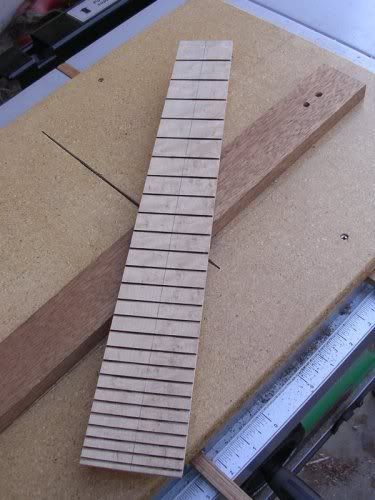 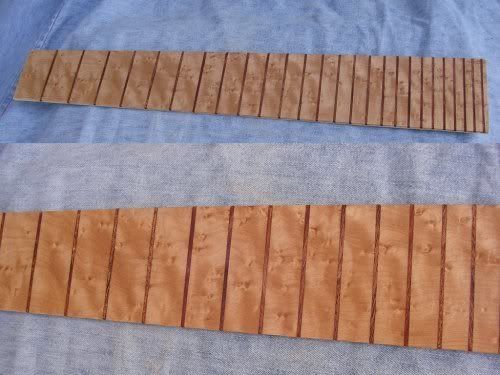

On my neck through designs, I've been inlaying strait to the neck without a separate board.
I use the same sled for the slots. The wood dots I make with a standard 1/4" plug cutter.
.
 
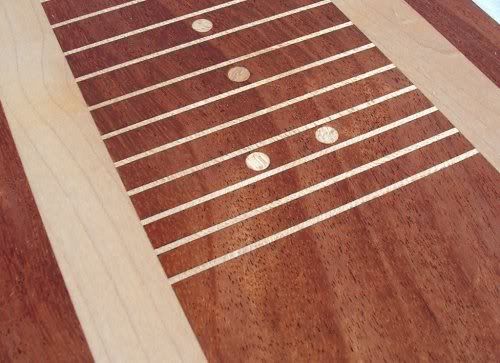
Here is one I'm working on now. I used aluminum sheet for the markers and aluminum tubing for the abalone bezel surrounds.
.
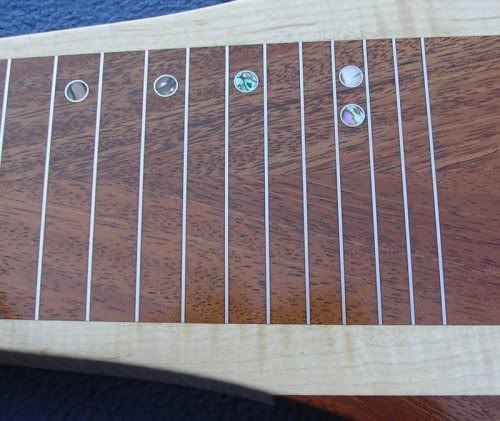
Hope this helps some. If you have any questions or need some help, just ask. Glad to help if I can 
_________________
Some misc pics of my hand crafted steels
Follow me on Facebook here |
|
|
 |
Ron Whitfield
From:
Kaaawa, Hawaii, USA
|
 Posted 6 Sep 2007 10:34 am
Posted 6 Sep 2007 10:34 am |
|
Gawd, every time I look at Tom's work I dig it even more.
Gotta get one (or more) some day. |
|
|
 |
Bruce Freisinger
From:
New Hampshire, USA
|
 Posted 6 Sep 2007 11:34 am
Posted 6 Sep 2007 11:34 am |
|
Good Lord, Tom, that's some beautiful work. I especially love your most recent 'board there with the aluminum inlays. I'm just blown away by your handiwork. Amazing!
And thanks a million for the tip on the engraving plates! That sounds like a easy way to go for a beginner to home-made stuff like me. I'll definitely give that a look.
Thank you to everyone for chiming in with their ideas ans stuff in this thread. Once again, you guys amaze me with your generosity and friendliness to, what amounts to, a perfect stranger like me. You guys rock! 
-Bruce |
|
|
 |
Tom Pettingill
From:
California, USA (deceased)
|
 Posted 6 Sep 2007 11:55 am
Posted 6 Sep 2007 11:55 am |
|
Thanks Ron, I really enjoy building them. Only problem is that I can't play them worth a dam, but its a fun journey non the less.
Bruce, thanks to you too, and happy to see you give it a try.
Building your own is a very rewarding experience.
And like I said, if there is anything I can do to help, just let me know.
Here is a in progress shot of the newest.
I'm liking how it turning out.
.
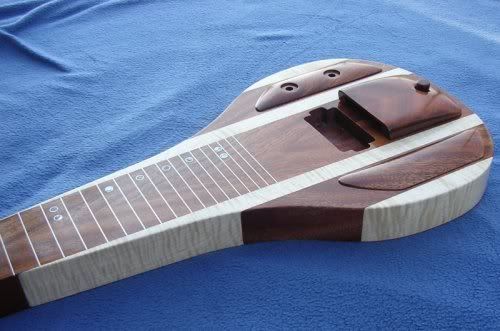
_________________
Some misc pics of my hand crafted steels
Follow me on Facebook here |
|
|
 |
Bruce Freisinger
From:
New Hampshire, USA
|
 Posted 6 Sep 2007 1:11 pm
Posted 6 Sep 2007 1:11 pm |
|
| Wow, nice finish work on those top carved plates, Tom. Now that you mention it, I do have another question for you. Where do you purchase your tonewoods? I think I'm going to end up using www.rockler.com, but I'd be interested any other suggestions you may have. |
|
|
 |
Tom Pettingill
From:
California, USA (deceased)
|
 Posted 6 Sep 2007 2:03 pm
Posted 6 Sep 2007 2:03 pm |
|
Bruce, I buy most of my wood from a couple of local hardwood dealers.
The boards come in random widths and 8' and up lengths.
African mahogany / Kaya runs me around $5.50 a board ft and maple around $4.80.
Check your local area for some hardwood dealers and or or check with some cabinet shops and see where they get their stock.
A cabinet shop may also have some for sale and be able to plane and thickness a piece for you for a small fee.
_________________
Some misc pics of my hand crafted steels
Follow me on Facebook here |
|
|
 |
Rick Aiello
From:
Berryville, VA USA
|
 Posted 6 Sep 2007 2:19 pm
Posted 6 Sep 2007 2:19 pm |
|
| Quote: |
| Here is a in progress shot of the newest. |
Stunning ...  |
|
|
 |
Chris Drew
From:
Bristol, UK
|
 Posted 6 Sep 2007 2:32 pm
Posted 6 Sep 2007 2:32 pm |
|
Tom, you have created a thing of beauty!
Those dot's look so sweet with that border... have you done many like that before? Any pics of those but with copper or brass?
Anyway Bruce, the technique I used was pretty simple, a cheap way to fake an inlay.
I'm guessing you already know what fret distances to use, I used one of the online fret calculators, there's lots out there.
You'll need a .ai or similar vector-graphic image file of the fretboard, fret-lines & any dots or other decoration, scaled to the size of your fretboard.
( If you aren't familiar with software that makes vector-graphic image files then I could help you out with that, just let me know what scale length & how many frets, etc )
Take or email it to a vinyl-cutter/sign shop, and they'll cut the vinyl for you.
Have them use the thinnest vinyl they have, 100 microns(0.1mm) is thin enough.
You can get pretty-much any shade of any colour you could think of, including metallic foil effect.
( I couldn't find any mother-of-pearl effect. )
When you stick it onto the board, positioning the frets & dots is no problem at all, the cut vinyl is on a tacky clear sheet (carrier film), just peel off the backing & stick it on. Then peel off the carrier film.
Over lacquer it quite heavily, only cut back the finish when the lacquer is thick enough.
With a reasonable number of coats the finish is thick enough to lose any bumps made by the vinyl underneath.
For the board itself I used a rosewood veneer from this mail-order marquetry supplier I found online, anita marquetry.
Let me know how you get on, or if you want a hand with the .ai file or anything else. |
|
|
 |
Mark White
From:
Michigan, USA
|
 Posted 6 Sep 2007 2:40 pm
Posted 6 Sep 2007 2:40 pm |
|
Tom, I've admired your earlier models but I think you've outdone yourself on this newest guitar, beautiful work, wow!  |
|
|
 |
Bill Creller
From:
Saginaw, Michigan, USA (deceased)
|
 Posted 6 Sep 2007 9:24 pm
Posted 6 Sep 2007 9:24 pm |
|
| For those wanting to make their own fret boards, there is Stewart Macdonald's fret/scale calculator on their site, for any scale length you desire. |
|
|
 |
Tom Pettingill
From:
California, USA (deceased)
|
 Posted 7 Sep 2007 7:03 am
Posted 7 Sep 2007 7:03 am |
|
Thanks all ... you are all too kind 
Chris, thats the first one I've done with the bezels around the inlay like that.
Lots of possabilitys with differnt materials to explore.
Great idea with the vinyl by the way 
For those needing a vector graphics program, Inkscape is an Open Source vector graphics editor thats been getting some good reviews.
http://www.inkscape.org/
Bill, the Stew Mac calculator is what I've been using. http://www.stewmac.com/FretCalculator/
Its very handy and user friendly.
For me, I like to convert my scale length to millimeter and work off the metric, it just seems easier to read for me.
Also, take all measurements from the nut. The fret to fret measurements are nice for reference, but if used for layout, any errors can be compounded and put you way off by the time you layout the last frets.
_________________
Some misc pics of my hand crafted steels
Follow me on Facebook here |
|
|
 |
Bruce Freisinger
From:
New Hampshire, USA
|
 Posted 7 Sep 2007 9:53 am
Posted 7 Sep 2007 9:53 am |
|
| Tom Pettingill wrote: |
Bill, the Stew Mac calculator is what I've been using. http://www.stewmac.com/FretCalculator/
Its very handy and user friendly.
For me, I like to convert my scale length to millimeter and work off the metric, it just seems easier to read for me.
Also, take all measurements from the nut. The fret to fret measurements are nice for reference, but if used for layout, any errors can be compounded and put you way off by the time you layout the last frets. |
So a 22.5" scale would equal 571.5mm, is that correct, or is math too hard for Bruce?  |
|
|
 |
Tom Pettingill
From:
California, USA (deceased)
|
|
|
 |
Alan Brookes
From:
Brummy living in Southern California
|
 Posted 7 Sep 2007 12:03 pm
Posted 7 Sep 2007 12:03 pm |
|
Bruce: The traditional method of building a fretboard/fingerboard is to calculate the positions of the frets, (which used to be done longhand, taking a long time, but nowadays is usually done using an Excel spreadsheet which I can send anyone who doesn't have it), or copy the positions from an existing fretboard with identical string length, then mark them on the bare wood. (I prefer to cover the wood with masking tape and draw the frets on the masking tape using a pencil or ball-point pen and a T-square.) Then you get a saw of the right thickness and make cuts deep enough for the fretting material. Then you get fret material, which comes ready-made in coils or straight lengths. (I prefer the shorter straight lengths which don't need straightening out.) Then you cut each fret to its required length. (Unless your fingerboard is parallel each fret will be of a different length, so you have to keep them in order after you've cut them.) Then you tap the frets into the grooves that you've cut. Finally you file the burred edges of the frets to avoid cut fingers when playing.
On a lap steel some people avoid the expense of using fretting material by painting the frets. Again, mark them onto the masking tape, but this time get a craft knife and cut away the tape in consistently-wide stripes at the fret markings. Then paint over the fingerboard. When all is dry, remove the masking tape and you have only the fret positions painted.
Another way is to use perspex, repeat the process above, but on the back-side of the fingerboard, remove the masking tape and you have a clear fingerboard with frets showing through, but this way the frets won't get rubbed off over the years with use.
Many manufacturers set up a die and pressure-stamp the fingerboard into brass or aluminium. Then they plate the parts that stick out (the frets) and paint the background. You wouldn't want to do this unless you were investing in producing hundreds of the same fingerboard.
Again, if you want to make thousands you could invest in a plastic-injection mold... |
|
|
 |




